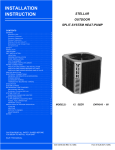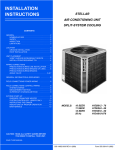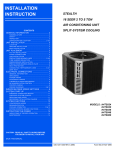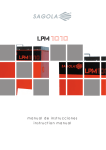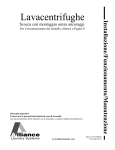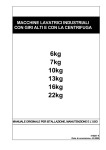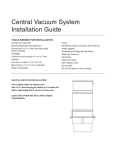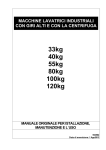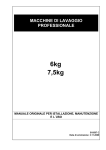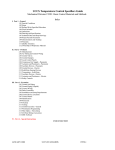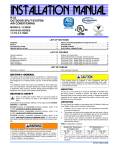Download York E4FD018-60 Unit installation
Transcript
INSTALLATION INSTRUCTION STELLAR OUTDOOR SPLIT-SYSTEM HEAT PUMP CONTENTS GENERAL . . . . . . . . . . . . . . . . . . . . . . . . . . . . . . . . . . . . . . . . . . . 2 NOMENCLATURE . . . . . . . . . . . . . . . . . . . . . . . . . . . . . . . . . . . . . . 2 PRODUCT CATEGORY . . . . . . . . . . . . . . . . . . . . . . . . . . . . . . . . . . 2 PRODUCT GENERATION . . . . . . . . . . . . . . . . . . . . . . . . . . . . . . . . . 2 PRODUCT IDENTIFIER . . . . . . . . . . . . . . . . . . . . . . . . . . . . . . . . . . 2 NOMINAL COOLING CAPACITY . . . . . . . . . . . . . . . . . . . . . . . . . . . . 2 REFRIGERANT LINE CONNECTIONS . . . . . . . . . . . . . . . . . . . . . . . . 2 VOLTAGE CODE . . . . . . . . . . . . . . . . . . . . . . . . . . . . . . . . . . . . . . 2 SAFETY . . . . . . . . . . . . . . . . . . . . . . . . . . . . . . . . . . . . . . . . . . . . . 2 INSPECTION . . . . . . . . . . . . . . . . . . . . . . . . . . . . . . . . . . . . . . . . . 2 LIMITATIONS . . . . . . . . . . . . . . . . . . . . . . . . . . . . . . . . . . . . . . . . . 2 UNIT INSTALLATION . . . . . . . . . . . . . . . . . . . . . . . . . . . . . . . . . . 3 LOCATION . . . . . . . . . . . . . . . . . . . . . . . . . . . . . . . . . . . . . . . . . 3 GROUND INSTALLATION . . . . . . . . . . . . . . . . . . . . . . . . . . . . . 3 ROOF INSTALLATION . . . . . . . . . . . . . . . . . . . . . . . . . . . . . . . . 3 UNIT PLACEMENT . . . . . . . . . . . . . . . . . . . . . . . . . . . . . . . . . . . 3 DISCHARGE LINE FILTER-DRIER . . . . . . . . . . . . . . . . . . . . . . 4 PIPING CONNECTIONS . . . . . . . . . . . . . . . . . . . . . . . . . . . . . . 4 PRECAUTIONS DURING LINE INSTALLATION . . . . . . . . . . . . 4 PRECAUTIONS DURING BRAZING OF LINES . . . . . . . . . . . . 5 PRECAUTIONS DURING BRAZING ANGLE VALVE . . . . . . . . 5 ORIFICE SELECTION . . . . . . . . . . . . . . . . . . . . . . . . . . . . . . . . . . 7 ELECTRICAL CONNECTIONS . . . . . . . . . . . . . . . . . . . . . . . . . . . 7 GENERAL INFORMATION & GROUNDING . . . . . . . . . . . . . . . 7 POWER WIRING . . . . . . . . . . . . . . . . . . . . . . . . . . . . . . . . . . . . 7 ACCESSORY WIRING . . . . . . . . . . . . . . . . . . . . . . . . . . . . . . . . 7 THERMOSTAT MOUNTING / WIRING . . . . . . . . . . . . . . . . . . . 7 EVACUATION . . . . . . . . . . . . . . . . . . . . . . . . . . . . . . . . . . . . . . . . 9 SYSTEM CHARGE . . . . . . . . . . . . . . . . . . . . . . . . . . . . . . . . . . . . 9 REFRIGERANT LINE CHARGES . . . . . . . . . . . . . . . . . . . . . . . . . 9 MEASUREMENT METHOD . . . . . . . . . . . . . . . . . . . . . . . . . . . . . . . . 9 SUPERHEAT CHARGING METHOD . . . . . . . . . . . . . . . . . . . . . . . . . 10 SYSTEM START-UP . . . . . . . . . . . . . . . . . . . . . . . . . . . . . . . . . . 10 ENERGIZE CRANKCASE HEATER . . . . . . . . . . . . . . . . . . . . . 10 SYSTEM OPERATION. . . . . . . . . . . . . . . . . . . . . . . . . . . . . . . . . 10 SEQUENCE OF OPERATION COOLING: . . . . . . . . . . . . . . . . . 10 HEATING: . . . . . . . . . . . . . . . . . . . . . . . . . . . . . . . . . . . . . . . . . 10 EMERGENCY HEAT: . . . . . . . . . . . . . . . . . . . . . . . . . . . . . . . . 11 DEFROST: . . . . . . . . . . . . . . . . . . . . . . . . . . . . . . . . . . . . . . . . 11 TEST PIN: . . . . . . . . . . . . . . . . . . . . . . . . . . . . . . . . . . . . . . . . . 11 INSTRUCTING THE OWNER . . . . . . . . . . . . . . . . . . . . . . . . . . . 12 INDICATIONS OF PROPER OPERATION . . . . . . . . . . . . . . . . . 12 COOLING . . . . . . . . . . . . . . . . . . . . . . . . . . . . . . . . . . . . . . . . . 12 HEATING . . . . . . . . . . . . . . . . . . . . . . . . . . . . . . . . . . . . . . . . . 13 MAINTENANCE . . . . . . . . . . . . . . . . . . . . . . . . . . . . . . . . . . . . 13 MODELS: 10 SEER 1 PH 208/230 V 3 PH 208/230 V 3 PH 460 V E4FD018 - 60 E4FD036 - 60 E4FD036 - 60 CAUTION:READ ALL SAFETY GUIDES BEFORE YOU BEGIN TO INSTALL YOUR UNIT. SAVE THIS MANUAL 035-17421-000 REV B (700) GENERAL The outdoor units are designed to be connected to a matching indoor coil with sweat connect lines. Sweat connect units are factory charged with refrigerant for a matching indoor coil plus 15 feet of field supplied lines. This product must be installed in strict compliance with the enclosed installation instructions and any applicable local, stat, and national codes including, but not limited to, building, electrical and mechanical codes. NOMENCLATURE E 4 FD 030 S 06 Product Category E = Outdoor Split System Heat Pump Product Generation 4 = Design Level Incorrect installation may create a condition where the operation of the product could cause personal injury or property damage. Product Identifier FD = 10 SEER Heat Pump (60 Hz) Nominal Cooling Capacity 018 = 1.5 Tons 042 = 3.5 Tons 024 = 2 Tons 048 = 4 Tons 030 = 2.5 Tons 060 = 5 Tons 036 = 3 Tons Refrigerant Line Connections S = Sweat-Fittings Voltage Code 06 = 208/230-1-60 25 = 208/230-3-60 46 = 460-3-60 Matching indoor coils are available with a thermal expansion valve or an orifice liquid feed (YORKMATE flow control device) sized for the most common usage. The orifice size and/or refrigerant charge may need to be changed for some indoor-outdoor unit combinations, elevation differences or total line lengths. Refer to Application Data covering “General Piping Recommendations and Refrigerant Line Length” (Form 690.01-AD1V). INSPECTION As soon as a unit is received, it should be inspected for possible damage during transit. If damage is evident, the extent of the damage should be noted on the carrier’s delivery receipt. A separate request for inspection by the carrier’s agent should be made in writing. See Local Distributor for more information. LIMITATIONS The unit should be installed in accordance with all national and local safety codes and the limitations listed below: 1. Limitations for the indoor unit, coil and appropriate accessories must also be observed. 2. The outdoor unit must not be installed with any duct work in the air stream. The outdoor fan is the propeller type and is not designed to operate against any additional external static pressure. 3. The maximum and minimum conditions for operation must be observed to assure a system that will give maximum performance with minimum service. SAFETY Use this instruction in conjunction with the instruction for the appropriate indoor evaporator coil, variable speed air handler or furnace and other accessories. Read all instructions before installing the unit. Installer should pay particular attention to the words: NOTE, CAUTION and WARNING. Table 1: Application Limitations AIR TEMPERATURE °DB ON OUTDOOR COIL Min. NOTES are intended to clarify or make the installation easier. CAUTIONS are given to prevent equipment damage. WARNINGS are given to alert the installer that personal injury and/or equipment damage may result if installation procedures are not handled properly. 2 AIR TEMPERATURE ON INDOOR COIL Max. Min. Cool Heat Cool Heat °WB Cool 50 -10* 115 75 57 Max. °DB Heat °WB Cool °DB Heat 50† 72 80 *. Below -10°F, the unit operates automatically with resistance heat only. †. Operation below this temperature is permissible for a short period of time, during morning warm-up. Unitary Products Group 035-17421-000 Rev B (700) TO BLOWER MOTOR RELAY WEATHERPROOF DISCONNECT SWITCH THERMOSTAT TO POWER SUPPLY NEC CLASS 1 WIRING 48” OVERHEAD CLEARANCE 12” REAR REQUIRED AND SIDES CLEARANCE REQUIRED Sit unit on rubber elevator grommets to reduce noise and allow for proper drainage. NEC CLASS 2 WIRING TO COIL NOTE: ALL OUTDOOR WIRING MUST BE WEATHERPROOF 24” SERVICE ACCESS CLEARANCE REQUIRED SEAL OPENING(S) WITH PERMAGUM OR EQUIVALENT FIGURE 1: TYPICAL INSTALLATION UNIT INSTALLATION LOCATION Condensate will drain from beneath the coil of the outdoor unit during the defrost cycle. Normally this condensate may be allowed to drain directly on the ground. Before starting the installation, select and check the suitability of the location for both the indoor and outdoor unit. Observe all limitations and clearance requirements. The outdoor unit must have sufficient clearance for air entrance to the condenser coil, for air discharge and for service access. See Figure 1. The outdoor unit should not be installed in an area where mud or ice could cause personal injury. Remember that condensate will drip from the unit coils during heat and defrost cycles and that this condensate will freeze when the temperature of the outdoor air is below 32*F. If the unit is to be installed on a hot sun exposed roof or a black-topped ground area, the unit should be raised sufficiently above the roof or ground to avoid taking the accumulated layer of hot air into the outdoor unit. Provide an adequate structural support. GROUND INSTALLATION The unit may be installed at ground level on a solid base that will not shift or settle, causing strain on the refrigerant lines and possible leaks. Maintain the clearances shown in Figure 1 and install the unit in a level position. Isolate the base from the structure to avoid noise or vibration transmission. Isolate the unit from rain gutters to avoid any possible wash out of the foundation. Normal operating sound levels may be objectionable if the unit is placed directly under windows of certain rooms (bedrooms, study, etc.). Unitary Products Group Elevate the unit sufficiently to prevent any blockage of the air entrances by snow in areas where there will be snow accumulation. Check the local weather bureau for the expected snow accumulation in your area. ROOF INSTALLATION When installing units on a roof, the structure must be capable of supporting the total weight of the unit, including a pad, lintels, rails, etc., which should be used to minimize the transmission of sound or vibration into the conditioned space. UNIT PLACEMENT 1. Provide a base in the pre-determined location. 3 2. Remove the shipping carton and inspect for possible damage. 3. Compressor tie-down bolts should remain tightened. 4. Position the unit on the base provided. 5. Sit unit on the (4) rubber elevating grommets provided with the unit. These should be positioned as shown in Figure 2 to reduce noise and allow for proper drainage. 6. Make a hole(s) in the structure wall large enough to accommodate the insulated vapor line, the liquid line and the wiring. Failure to do so or using a substitute drier or a granular type may result in damage to the equipment. Filter-Drier Source 1 Part No. UNIT BASE PAN RUB BE R ELEVA TING GRO M M E TS (4) Note:DoNotblockdrainage holeswithgrom m ets. UNIT BASE PAN RUB BE R ELEVA TING GRO M M E TS (4) 026 - 35442 - 000 018, 024, 030, 036 026 - 25596 - 001 042 026 - 25512 - 000 048, 060 (Bi-flow on Liquid Line) The outdoor condensing unit may be connected to the indoor evaporator coil using field supplied refrigerant grade copper tubing that is internally clean and dry. Units should be installed only with the tubing sizes for approved system combinations as specified in Tabular Data Sheet. The charge given is applicable for total tubing lengths up to 15 feet. See Application Data Form 690.01-AD1V for installing tubing of longer lengths and elevation differences. NOTE: Using a larger than specified line size could result in oil return problems. Using too small a line will result in loss of capacity and other problems caused by insufficient refrigerant flow. Slope horizontal vapor lines at least 1" every 20 feet toward the outdoor unit to facilitate proper oil return. PRECAUTIONS DURING LINE INSTALLATION 1. Install the lines with as few bends as possible. Care must be taken not to damage the couplings or kink the tubing. Use clean hard drawn copper tubing where no appreciable amount of bending around obstruction is necessary. If soft copper must be used, care must be taken to avoid sharp bends which may cause a restriction. 2. The lines should be installed so that they will not obstruct service access to the coil, air handling system or filter. 3. Care must also be taken to isolate the refrigerant lines to minimize noise transmission from the equipment to the structure. 4. The vapor line must be insulated with a minimum of 1/2" foam rubber insulation (Arm-A-Flex or equivalent). Liquid lines that will be exposed to direct sunlight and/or high temperatures must also be insulated. DISCHARGE LINE FILTER-DRIER NOTE: Replacement of the discharge line drier must be the exact same as marked on the original factory drier. See Source 1 for O.E.M. replacement driers. E*FD PIPING CONNECTIONS FIGURE 2 : POSITIONING GROMMETS The E*FD 018 - 042 heat pumps have a solid core filter-drier located in the discharge line. Due to its location in the refrigerant circuit it requires a unique oversize capacity drier. E*FD 048 and 060 have a solid core bi-flow filter/dryer on the liquid line. Apply with models: Tape and suspend the refrigerant lines as shown. DO NOT allow metal-to metal contact. See Figure 3. 4 Unitary Products Group 035-17421-000 Rev B (700) 5. 6. Total line lengths are limited to 75 feet due to the storage capacity of the accumulator. Systems with total line lengths over 50 feet must be provided with a low voltage start kit. Elevation differences are limited to: Dry nitrogen should always be supplied through the tubing while it is being brazed, because the temperature required is high enough to cause oxidation of the copper unless an inert atmosphere is provided. The flow of dry nitrogen should continue until the joint has cooled. Always use a pressure regulator and safety valve to insure that only low pressure dry nitrogen is introduced into the tubing. Only a small flow is necessary to displace air and prevent oxidation. Indoor Above Outdoor 50 ft. Outdoor Above Indoor 50 ft. Use PVC piping as a conduit for all underground installations as shown in Figure 4. Buried lines should be kept as short as possible to minimize the build up of liquid refrigerant in the vapor line during long periods of shutdown. L IQ UID L IN E T AP E liquid and vapor connections. The total system refrigerant charge is retained within the outdoor unit during shipping and installation. The re-usable service valves are provided to evacuate and charge per this instruction. INC O R R EC T Serious service problems can be avoided by taking adequate precautions to assure an internally clean and dry system. SH EET METAL HAN G ER C O R R EC T FIGURE 3 : PRECAUTIONS DURING BRAZING ANGLE VALVE INSU LATED VAPO R LINE Precautions should be taken to prevent heat damage to angle valve by wrapping a wet rag around it as shown in Figure 5. Also, protect all painted surfaces and insulation during brazing. After brazing - cool joint with wet rag. TUBING HANGER TO INDOOR COIL LIQUID LINE TO OUTDOOR UNIT INSULATED CAP This is not a backseating valve. The service access port has a valve core. Opening or closing valve does not close service access port. VAPOR LINE PVC CONDUIT FIGURE 4 : 7. 8. If the valve stem is backed out past the retaining ring, the O-ring can be damaged causing leakage or system pressure could force the valve stem out of the valve body possibly causing personal injury. In the event the retaining ring is missing, do not attempt to open the valve. UNDERGROUND INSTALLATION Pack fiber glass insulation and a sealing material such as permagum around refrigerant lines where they penetrate a wall to reduce vibration and to retain some flexibility. Valve can be opened by removing the plunger cap and fully inserting a hex wrench into the stem and backing out counterclockwise until valve stem just touches retaining ring. Replace plunger cap finger tight, then tighten an additional 1/ 12 turn (1/2 hex flat). Cap must be replaced to prevent leaks. See Form 690.01-AD1V for additional piping information. Connect the refrigerant lines using the following procedure: PRECAUTIONS DURING BRAZING OF LINES All outdoor unit and evaporator coil connections are copperto-copper and should be brazed with a phosphorous-copper alloy material such as Silfos-5 or equivalent. DO NOT use soft solder. 1. Remove the cap and Schrader core from both the liquid and vapor angle valve service ports at the outdoor unit. Connect low pressure nitrogen to the liquid line service port. The outdoor units have re-usable service valves on both the Unitary Products Group 5 7. Evacuate the vapor line, evaporator and the liquid line, to 500 microns or less. 8. Leak test all refrigerant piping connections including the service port flare caps to be sure they are leak tight. DO NOT OVERTIGHTEN (between 40 and 60 inch - lbs. maximum). NOTE: Do not use the system refrigerant in the outdoor unit to purge or leak test. 9. FIGURE 5 : HEAT PROTECTION If visual verification of the valve stem reaching the retaining ring is impossible, stop backing out the.valve stem when the slightest increase in resistance is felt. Because of the small size and therefore the reduced resistance, back out the liquid valve 5 turns maximum to prevent going past the retaining ring. 2. Braze the liquid line to the liquid valve at the outdoor unit. Be sure to wrap the valve body with a wet rag. Allow the nitrogen to continue flowing. 3. Carefully remove the rubber plugs from the evaporator liquid and vapor connections. The evaporator is pressurized. 4. Braze the liquid line to the evaporator liquid connection. The nitrogen should now be flowing through the evaporator coil. 5. Slide the grommet away from the vapor connection at the coil. Braze the vapor line to the evaporator vapor connection. After the connection has cooled, slide the grommet back into original position. 6. Protect the vapor valve with a wet rag and braze the vapor line connection. The nitrogen flow should be exiting the system from the vapor service port connection. After this connection has cooled, remove the nitrogen source from the liquid fitting service port. 6 Do not remove the flare caps from the service ports except when necessary for servicing the system. Do not connect manifold gauges unless trouble is suspected. Approximately 3/4 ounce of refrigerant will be lost each time a standard manifold gauge is connected. 10. Release the refrigerant charge into the system. Open both the liquid and vapor valves by removing the plunger cap and with an allen wrench back out counter-clockwise until valve stem just touches retaining ring. Release the refrigerant charge into the system. See “Precautions During Brazing Angle Valves" on page 6. 11. If the refrigerant tubing, indoor evaporator coil or outdoor condensing unit has developed a leak during shipment, or was, for any other reason, opened to the atmosphere for more than four (4) minutes, it is necessary to evacuate the system down to at least 500 microns to eliminate contamination and moisture in the system. If a leak is suspected, leak test to locate the leak. To verify the leak, close the valve to the vacuum pump suction to isolate the pump and hold the system under vacuum. If the micron gauge indicates a steady and continuous rise after a few minutes, it's an indication of a leak. If the gauge shows a rise, then levels off after a few minutes and remains fairly constant, its an indication that the system is leak free, but still contains moisture and may require further evacuation if the reading is above 1000 microns. Never attempt to repair any brazed connections while the system is under pressure. Personal injury could result. See "System Start Up" section for checking and recording system charge. Unitary Products Group 035-17421-000 Rev B (700) ORIFICE SELECTION POWER WIRING YORKMATE FLOW CONTROL COILS 1. NOTE: The proper orifice must be installed in the indoor coil liquid connection prior to the connection of the refrigerant lines. Install the proper size weatherproof disconnect switch outdoors and within sight of the unit. 2. Run power wiring from the disconnect switch to the unit. 3. Remove the control box cover to gain access to the unit wiring. Route wires from disconnect through power wiring opening provided and into the unit control box as shown in Figure 6. 4. Install the proper size time-delay fuses or circuit breaker, and make the power supply connections. 5. Energize the crankcase heater to save time by preheating the compressor oil while the remaining installation is completed. Sweat coil is under 35 PSIG helium pressure. Sweat coils are shipped with a standard orifice in a plastic bag attached to the liquid line connection or factory installed in the liquid line distributor. The standard orifice size is marked on the coil data plate. The orifice that is shipped with the coil is based on the “most sold” combination, but it may have to be changed, depending on the capacity and efficiency of the outdoor unit, elevation differences, and/or long total line lengths. An additional orifice(s) is shipped with most outdoor units in the literature packet for the most commonly required replacement combinations. Other sizes must be ordered from the Parts Department if required. CONTROL WIRING POWER WIRING LOW VOLTAGE JUNCTION BOX GROUND LUG See the appropriate Tabular Data Sheet for the correct orifice size. If the orifice sizes match, nothing further is required and the refrigerant lines may be connected per the outdoor unit instruction. However, if another orifice should be used, see the coil instruction for details to change the orifice in the coil. ELECTRICAL CONNECTIONS GENERAL INFORMATION & GROUNDING All outdoor wiring must be weatherproof. Use copper conductors only. Check the electrical supply to be sure that it meets the values specified on the unit nameplate and wiring label. Power wiring, control (low voltage) wiring, disconnect switches and over current protection to be supplied by the installer. Wire size should be sized per NEC requirements. FIGURE 6 : TYPICAL FIELD WIRING ACCESSORY WIRING All field wiring must USE COPPER CONDUCTORS ONLY and be in accordance with Local, National Fire, Safety & Electrical Codes. This unit must be grounded with a separate ground wire in accordance with the above codes. The complete connection diagram and schematic wiring label is located on the inside surface of the unit electrical box cover and this instruction. Unitary Products Group The electrical accessories available for this unit are a two stage cooling thermostat and an optional De-humidification Control. Refer to the individual instructions packaged with the accessories for installation. THERMOSTAT MOUNTING / WIRING This condensing unit must be installed with the factory recommended thermostat, or any conventional heat pump thermostat. The thermostat should be located about 5 ft. above the floor, where it will be exposed to normal room air circulation. Do not place it on an outside wall or where it is exposed to the radiant effect from exposed glass or appliances, drafts from outside doors or supply air grilles. 7 ALL WIRING TO BE IN ACCORDANCE WITH NATIONAL ELECTRIC CODE AND/OR LOCAL CODES THERMOSTAT INDOOR UNIT OUTDOOR UNIT LOW VOLTAGE TERMINAL BLOCK 3,4 IN AIR HANDLER WITH ELECTRIC HEAT R 7 WIRES RED R BLK C B or C YEL Y Y O O W W2 T2 C GRD. SCREW Y CONTACTOR O BRN PRP W T2 X T1 M WHT G 1 FIELD R ORG L or X G DEFROST CONTROL W1 L2 L1 W1 INSTALLED JUMPER E2 1 2 GRD. LUG Jumper terminals E and W to heat on first stage during Emergency Heat. Terminal not used on all thermostats. POWER WIRING 208/230-1-60 CIRCUIT BREAKER*** POWER WIRING 24V CONTROL WIRING (NEC CLASS 2) 3 4 Check the low voltage terminal block on the indoor unit for the actual arrangement of the terminals. Connect power wiring to terminal block 3TB on units without electric heat or circuit breaker. FIGURE 7 : TYPICAL 1 PHASE FIELD WIRING (AIR HANDLER / ELECTRICAL HEAT) ALL WIRING TO BE IN ACCORDANCE WITH NATIONAL ELECTRIC CODE AND/OR LOCAL CODES INDOOR UNIT OUTDOOR UNIT CONTA CTOR T3 T2 T1 POWER GRD. GRD. M SUPPLY SCREW 208/230-3-60 460-3-60 LUG L3 L2 L1 POWER WIRING POWER WIRING 208/230-3-60 460-3-60 FIGURE 8 : TYPICAL 3 PHASE FIELD WIRING (AIR HANDLER / ELECTRICAL HEAT) 8 Unitary Products Group 035-17421-000 Rev B (700) After the thermostat is mounted, route the 24-volt control wiring (NEC Class 2) from the thermostat to the indoor air handler and outdoor unit. Route the control wiring into the grommeted hole in the bottom of control box of the outdoor unit. Using wire nuts connect to leads inside the low voltage junction shown in Figure 6 and wiring diagrams shown in Figures 7 and 8. Interconnecting control wiring must be a minimum of No. 18 AWG color coded insulated wires. If wire lengths increase more than 90 feet, use No. 16 AWG wires, to prevent excessive voltage drop. NOTE: To eliminate erratic operation, seal the hole in the wall at the thermostat with permagum or equivalent to prevent air drafts affecting the anticipators in the thermostat. REFRIGERANT LINE CHARGES The outdoor condensing unit may be connected to the indoor evaporator coil using field supplied refrigerant grade copper tubing that is internally clean and dry. Units should be installed only with the tubing sizes for approved system combinations as specified in Tabular Data Sheet. The charge given is applicable for total tubing lengths up to 15 feet. See Application Data Form 690.01-AD1V for installing tubing of longer lengths and elevation differences. NOTE: Using a larger than specified line size could result in oil return problems. Using too small a line will result in loss of capacity and other problems caused by insufficient refrigerant flow. Slope horizontal vapor lines at least 1" every 20 feet toward the outdoor unit to facilitate proper oil return. Table 2: REFRIGERANT LINE CHARGES EVACUATION It will be necessary to evacuate the system if the unit has developed a leak during shipment or was, for any other reason, opened to the atmosphere. If a leak is suspected, leak test to locate the leak. Repair the leak and test again. To verify if the system has no leaks, simply close the valve to the vacuum pump suction to isolate the pump and hold the system under vacuum. Watch the micron gauge for a few minutes. If the micron gauge indicates a steady and continuous rise, it’s an indication of a leak. If the gauge shows a rise, then levels off after a few minutes and remains fairly constant, its an indication that the system is leak free but still contains moisture and may require further evacuation if the reading is above 500 microns. Refrigerant charging should only be carried out by a qualified air conditioning contractor with proper certification SYSTEM CHARGE Refrigerant charging should only be carried out by a qualified air conditioning contractor with proper certification. LIQUID OD VAPOR OD R-22 CHARGE OZ./FT. 3/8" 5/8" 0.66 3/8" 3/4" 0.68 3/8" 7/8" 0.70 3/8" 1-1/8" 0.76 Sweat connect units also include sufficient charge for 15 feet of lines. Table 2 lists the refrigerant line charges. The “TOTAL SYSTEM CHARGE” must be permanently stamped on the unit data plate. Total system charge is determined as follows: 1. Determine outdoor unit charge from tabular data sheet. 2. Determine indoor coil adjustment from tabular data sheet. 3. Calculate the line charge with the factors in Table 2 for sweat lines in excess of 15 ft. NOTE: The line charge over 15 feet should be included on the data plate and must be added to the system. 4. Total system charge = item 1 + item 2 + item 3. 5. Permanently stamp the unit data plate with the total amount of refrigerant in the system. USE THE FOLLOWING CHARGING METHOD WHENEVER ADDITIONAL REFRIGERANT IS REQUIRED FOR THE SYSTEM CHARGE. Measurement Method The factory charge in the outdoor unit includes enough charge for the unit and a most sold matched evaporator. A calibrated charging cylinder or accurate weighing device must be used to add refrigerant. This is the only accurate charging method for heat pumps in the heat pump mode. Check flare caps on service ports to be sure they are leak tight. DO NOT OVERTIGHTEN (between 40 and 60 inch-lbs. maxi-mum). Unitary Products Group 9 Superheat Charging Method NOTE: Use this method only during system maintenance and repair. 1. Operate system until temperatures and pressures stabilize (minimum of 10 minutes). 2. Measure and record indoor wet bulb (WB) temperature using a sling psychrometer and the outdoor dry bulb (DB) temperature using a thermometer. 3. Measure and record the suction pressure at the suction service valve port. 4. Using Table 3, note the superheat value corresponding to the intersection of the indoor wet bulb and the outdoor dry bulb. 5. With the superheat value obtained in step 4 and the suction pressure value from step 3, find the intersection of the values in Table 4. This is the required suction tube tempera-ture at the suction service valve. 6. To bring the tube temperature in line with the required value from Table 4, add refrigerant to the service port to cause the tube temperature to fall and reclaim refrigerant to cause the temperature to rise. Check flare caps on Schrader fittings to be sure they are tight. DO NOT OVERTIGHTEN (40-60 inch-lbs. maximum). door coil which is the condenser. The indoor coil is the evaporator. 2. If fan switch is in “ON” position, a circuit is made through blower relay to provide continuous blower operation. 3. When thermostat cooling contact closes, a circuit is made to energize contactor and start the system, if the compres-sor has been off for 5 minutes. There is an antishort cycle timer built into the defrost control requiring the compressor to be off at least 5 minutes. With fan switch in “AUTO” position, a circuit is made from thermostat cooling contact through blower relay to provide blower operation. 4. System will cycle with thermostat demand to provide cool-ing as needed. WITH POWER TO UNIT AND THERMOSTAT IN HEATING POSITION 1. Reversing valve is de-energized to position refrigerant cir-cuit for heating operation. In the heating cycle, discharge gas is pumped to the indoor coil which is the condenser. The outdoor coil is the evaporator. 2. If fan switch is in “ON” position, a circuit is made through blower relay to provide continuous blower operation. 3. When first stage of thermostat heating contact closes, a circuit is made through the control to energize contactor and start the system, if the compressor has been off 5 minutes. There is an anti-short cycle timer built into the defrost control requiring the compressor to be off at least 5 min-utes. With fan switch in “AUTO” position, a circuit is made from thermostat heating contact through blower relay to provide blower operation. 4. The system will cycle in response to thermostat signal to provide heating as needed. 5. Supplemental electric heaters are energized by second stage of heating thermostat. SYSTEM START-UP ENERGIZE CRANKCASE HEATER This unit is equipped with a crankcase heater for the compressor. A warning label with an adhesive back is supplied in the unit installation instruction packet. This label should be attached to the field supplied disconnect switch where it will be easily seen. See below. IMPORTANT An attempt to start the compressor without at least 8 hours of crankcase heat will damage the compressor. In order to energize the crankcase heater:- Set indoor two stage cooling thermostat to "OFF" position.- Close the line power disconnect to the unit. SYSTEM OPERATION See Figure 9 to trace the flow of refrigerant through the system. WITH POWER TO UNIT AND THERMOSTAT IN COOLING POSITION. 1. 10 Reversing valve is energized through thermostat system switch to position refrigerant circuit for cooling operation. In the cooling cycle, discharge gas is pumped to the out- SEQUENCE OF OPERATION COOLING: On call for cooling, the thermostat makes 24V circuits: R to O, R to Y, and R to G. Circuit R to O energizes the reversing valve, switching it to cooling position. Circuit R to Y energizes the contactor, starting outdoor fan motor and compressor (after the anti-short cycle period). Circuit R to G energizes the indoor unit blower relay, starting the indoor blower motor. HEATING: On call for heating, thermostat makes circuits R to Y and R to G. Circuit R to Y energizes contactor, starting outdoor fan motor and compressor (after the anti-short cycle period). Circuit R to G energizes the indoor blower relay, starting the blower motor. Should the temperature continue to fall, R to W is made through the second stage of the thermostat. Circuit R to W energizes the supplemental electric heat. The field-installed Unitary Products Group 035-17421-000 Rev B (700) FIELD CONNECTED LINE INDOOR COIL OUTDOOR COIL 4-WAY REVERSING VALVE* FIL TERDRY ER (solidc ore). SUCTION COMPRESSOR ACCUMULATOR FLOW RATER (cooling) LIQUID FLOW RAT ER (heating) SENSOR FIELD CONNECTED LINE COOLING CYCLE FLOW * SHOWN IN COOLING POSITION HEAT ING CYCLE FLOW FIGURE 9 : HEAT PUMP FLOW DIAGRAM option out-door thermostat can be used to turn on only the first stage of electric heat if the temperature is above the setting tempera-ture. If gas/propane furnace is used as the supplemental heat, add-on control kit (2AC02700701) must be used. See the add-on control installation instruction for the system operation. If the control detects a high pressure switch opening then it will send an output to turn on a fault indicator light at the thermostart through X/L terminal. Code flashed will be either 2 flashes if the pressure switch opens during cooling or heating mode or 3 flashes if the pressure switch opens during the defrost mode. EMERGENCY HEAT: To reset the lock out mode: When switch on thermostat is placed in emergency heat position: 1) Remove the 24V power from the Y or/and R for more than 2 second (turn off the system from the thermostart or power to the indoor air handler) 1. Emergency light is energized. 2. Compressor circuit is locked out. (No "R" to "Y") 3. Supplemental and standby heaters (if installed) will be controlled by first stage of heating thermostat. 4. Indoor blower will operate on demand for heat and cycle off with the last heater element when in “AUTO” position. SAFETY LOCKOUT MODE: The lock out control opens the circuits to the compressor contactor, stopping the compressor in respond to 400 +/-10 PSIG high pressure limit switch opening for more than 40 milliseconds. The compressor will remain off until the high pressure switch recloses and a 5 minutes antishort cycle timer has expired. When the compressor re-starts, a six hour timer shall be initialized to accumulate the compressor run time. If the hi pressure switch opens during his six hour run time, the compressor will be locked-out. If the high pressure switch does not open during this run time, the unit continues with normal operation. During locked-out, the defrost relay and the compressor contactor remain de-energized. Unitary Products Group 2) Connect a 1000 Ohm or smaller jumper across the "test" terminals for more than 2 seconds The control has the capability to sense a low voltage condition. If the voltage drops below 18 VAC, the control will not energize the compressor relay. If the unit is running when the voltage drops, the contactor will remain closed until it drops below 16 VAC. The antishort cycle timer will be initiated and the control will not bring the compressor back until the antishort cycle period is complete and the voltage is above 18VAC. DEFROST CYCLE: The defrost control is a time/temp control which includes a field-selectable time period between defrost cycle (30, 60, or 90 minutes). Factory set at 60 minutes. See figure 10. The electronic timer will accumulate the compressor run time. At the end of the setting cycle time(30. 60, or 90 minutes), the control will check the defrost thermostat status. If the defrost thermostat is closed, the defrost cycle will be initiated. The defrost thermostat is closed when the liquid temperature falls 11 30 RUN TIME TEST 60 X/L 90 R RUN TIME R7 C Time Selection Tap Y Test Pin PN 031-09104-000 O 6TT-3 W W1/66 R3 K3 K1 K2 REV PRESSURE DEST M VALVE SWITCH T’STAT M Pressure Switch Defrost Thermostat Reversing Valve Contactor Coil FIGURE 10 : TIME / TEMPERATURE DEFROST BOARD below approximately 31F. If the room thermostat opens during defrost, the control will resume operation in defrost when the thermostat re-closes. The defrost mode is identical to the cooling mode except that the outdoor fan motor stops and the first stage of heat (5KW if electric heat) is turned on through w1/66 to continue warming the conditioned space. The defrost cycle will be terminated when the defrost thermostat is opened at 55F or 10 minutes of compressor accumulated run time, whichever comes first. Note: the delay in the response of defrost thermostat may allow the coil temperature to reach 75-80F. The 10 minute timer will stop if the "Y" signal is dropped during defrost. TEST PIN: The "test" terminals are designed for two uses: 1. Anti-Short Cycle By-Pass — To by-pass the anti-short cycle feature in the control, jumper the two "test" terminals for at least 2 seconds. If there is a "Y" signal to the control, jumpering the test terminal will allow the control to pull in the unit contactor immediately. Note: do not hold the jumper on the test terminal for more than 9 seconds as the control will go into the defrost mode. 2. Forced Defrost — To force the unit into the defrost mode (24V to reversing valve and no fan operation) while the unit is operating, jumper the test terminals for 2 seconds if the unit was running (If the unit was not running and step 1 above was used to start the unit, then the "test" 12 terminals must be held for at least 10 seconds). When the short is removed, the heat pump will remain in defrost until the defrost thermostat opens or 10 minutes expires. If the thermostat is open when the short is removed, the heat pump will exit defrost immediately. INSTRUCTING THE OWNER Assist owner with processing warranty cards. Review User’s Information Manual and provide a copy for the owner guidance on proper operation and maintenance. Instruct the owner or the operator how to start, stop and adjust temperature setting. The owner should also be instructed about the 5 minute off cycletimer and the defrost operation. When applicable, instruct the owner that the compressor is equipped with a crankcase heater to prevent the migration of refrigerant to the compressor during the “OFF” cycle. The heater is energized only when the unit is not running. If the main switch is disconnected for long periods of shut down, do not attempt to start the unit for 8 hours after the switch has been connected. This will allow sufficient time for all liquid refrigerant to be driven out of the compressor. The installer should also instruct the owner on proper operation and maintenance of all other system components. INDICATIONS OF PROPER OPERATION COOLING Cooling operation is the same as any conventional air condi- Unitary Products Group 035-17421-000 Rev B (700) tioning unit. 1. The outdoor fan should be running, with warm air being discharged from the top of the unit. 2. The indoor blower (furnace or air handler) will be operating, discharging cool air from the ducts. coils or other parts in the air circuit. Clean as often as necessary to keep the unit clean. Use a brush, vacuum cleaner attachment, or other suitable means. 3. The vapor line at the outdoor unit will feel cool to the touch. 4. The liquid line at the outdoor unit will feel warm to the touch. HEATING Indications of proper Heating operation is as follows: 1. The outdoor fan should be running, with cool air being discharged from the top of the unit. 2. The indoor blower (furnace or air handler) will be opera ing, discharging warm air from the ducts. 3. The vapor line at the outdoor unit will feel warm to the touch. 4. The liquid line at the outdoor unit will feel cool to the touch. 5. The indoor coil drain pan should be inspected and cleaned regularly to prevent odors and assure proper drainage. IT IS UNLAWFUL TO KNOWINGLY VENT, RELEASE OR DISCHARGE REFRIGERANT INTO THE OPEN AIR DURING REPAIR, SERVICE, MAINTENANCE OR THE FINAL DISPOSAL OF THIS UNIT. WHEN THE SYSTEM IS FUNCTIONING PROPERLY AND THE OWNER HAS BEEN FULLY INSTRUCTED, SECURE THE OWNER’S APPROVAL. NOTICE TO OWNER: If lockout occurs, check the following before calling a serviceman: 1. Indoor section for dirty filter. 2. Outdoor section for snow accumulation. 3. Outdoor section for leaf or debris blockage. Eliminate problem, turn off the thermostat for 10 seconds and attempt start. Wait 5 minutes. If system does not start, call serviceman. MAINTENANCE 1. Dirt should not be allowed to accumulate on the outdoor coils or other parts in the air circuit. Clean as often as necessary to keep the unit clean. Use a brush, vacuum cleaner attachment, or other suitable means. 2. The outdoor fan motor is permanently lubricated and does not require periodic oiling. 3. If the coil needs to be cleaned, it should be washed with Calgon Coilclean (mix one part Coilclean to seven parts water). Allow solution to remain on coil for 30 minutes before rinsing with clean water. Solution should not be permitted to come in contact with painted surfaces. 4. Refer to the furnace or air handler instructions for filter and blower motor maintenance. Unitary Products Group 13 Table 3: - Superheat Value O U T D O °F O R IN D O O R D B W B °F* 55 60 50 9 7 52 12 10 6 54 14 12 10 7 56 17 15 14 10 6 58 20 18 16 13 9 5 60 23 21 19 16 12 8 6 62 26 24 22 19 16 12 8 5 64 29 27 24 21 18 15 11 9 6 66 32 31 30 24 23 18 15 11 9 6 68 35 33 30 27 24 21 19 16 14 35 33 30 28 25 22 20 35 33 30 28 26 34 31 35 70 72 65 70 75 74 76 *. 80 85 90 95 100 105 110 115 12 9 6 18 15 13 11 8 24 20 20 17 15 14 30 27 25 23 22 20 18 33 31 29 27 26 25 23 Evaporator Entering Air °F Table 4: Temperature and Pressure SUCTION PRESSURE PSIG (Service Port) 14 SUCTION SERVICE VALVE SUPERHEAT 0 2 4 6 8 10 12 14 16 18 20 22 24 26 28 30 32 34 61.5 35 37 39 41 43 45 47 49 51 53 55 57 59 61 63 65 67 69 64.2 37 39 41 43 45 47 49 51 53 55 57 59 61 63 65 67 69 71 67.1 39 41 43 45 47 49 51 53 55 57 59 61 63 65 67 69 71 73 70.0 41 43 45 47 49 51 53 55 57 59 61 63 65 67 69 71 73 75 73.0 43 45 47 49 51 53 55 57 59 61 63 63 67 69 71 73 75 77 76.0 45 47 49 51 53 55 57 59 61 63 65 67 69 71 73 75 77 79 79.2 47 49 51 53 55 57 59 61 63 65 67 69 71 73 75 77 79 81 82.4 49 51 53 55 57 59 61 63 65 67 69 71 73 75 77 79 81 83 Unitary Products Group 035-17421-000 Rev B (700) Table 5: Freon 22 Saturation Properties TEMP °F PRESSURE PSIG TEMP °F PRESSURE PSIG TEMP °F PRESSURE PSIG TEMP °F PRESSURE PSIG TEMP °F PRESSURE PSIG 45 76.023 60 101.62 75 132.22 90 168.40 105 210.75 46 77.584 61 103.49 76 134.45 91 171.02 106 213.81 47 79.165 62 105.39 77 136.71 92 173.67 107 216.90 48 80.767 63 107.32 78 138.99 93 176.35 108 220.02 49 82.389 64 109.26 79 141.30 94 179.06 109 223.17 50 84.03 65 111.23 80 143.63 95 181.80 110 226.35 51 85.69 66 113.22 81 145.99 96 184,56 111 229.56 52 87.38 67 115.24 82 148.37 97 187.36 112 232.80 53 89.08 68 117.28 83 150.78 98 190.18 113 236.08 54 90.81 69 119.34 84 153.22 99 193.03 114 239.38 55 92.56 70 121.43 85 155.68 100 195.91 115 242.72 56 94.32 71 123.54 86 158.17 101 198.82 116 246.10 57 96.11 72 125.67 87 160.69 102 201.76 117 249.50 58 97.93 73 127.83 88 163.23 103 204.72 118 252.94 59 99.76 74 130.01 89 165.80 104 207.72 119 256.41 Unitary Products Group 15 035-17421-000 Rev B (700) NOTES: H e a t in g a n d A ir C o n d it io n in g Unitary Products Group 5005 York Drive, Norman, Oklahoma 73069 Subject to change without notice. Printed in U.S.A. Copyright © by Unitary Products Group 1999. All rights reserved. 035-17421-000 RevB Supersedes: 035-17421-000 Rev A (02/00)
















